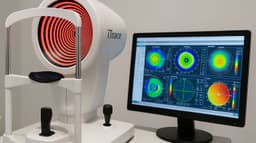
Cataracts - The Greenish Cloudiness Of The Lens
Having a cataract is now an opportunity, not a problem. Modern cataract surgery offers one of the most effective treatments in healthcare today, often restoring vision to levels many patients haven't experienced in years. Once treated, patients can return to a full and active life, frequently achieving better vision than they had before cataracts developed.
Download Your Free Brochure Here
This guide is designed to help you understand what modern cataract surgery involves, providing you with essential information to make confident, informed choices about your treatment. Please keep this guide handy as you prepare for your procedure. If you would prefer a quick guide to cataracts - please click here
The Evolution of Cataract Surgery
Cataract surgery has transformed remarkably over recent years. Today, you can choose to undergo surgery as soon as cataract symptoms begin to affect your daily life. By reading this brochure, you’ll gain valuable insights into your options, allowing you to make informed decisions that align with your vision needs.

What is a Cataract?
A cataract is a clouding of the lens in your eye, located just behind the pupil. This lens plays a crucial role in focusing light that enters the eye, forming a clear image on the retina. The retina then converts this image into a nerve impulse, which the brain interprets as sight.
In a healthy eye, the lens is crystal clear, allowing light to pass through effortlessly. However, when cloudiness develops in the lens, it obstructs light, leading to blurred vision. This cloudiness is known as a cataract. As the cataract progresses and vision worsens, surgery becomes necessary to remove the cloudy lens and replace it with a clear, artificial lens implant.

What is an Implant?
In cataract surgery, an implant—also known as an intraocular lens (IOL)—is a specially designed artificial lens that replaces the eye’s cloudy natural lens. Made from biocompatible materials, the IOL restores clarity by allowing light to pass through the eye unobstructed. There are several types of IOLs available, including monofocal lenses, which provide clear vision at one distance, and multifocal or toric lenses, which can correct for multiple vision needs, such as near, intermediate, and distance vision, or astigmatism. With the right implant, patients can often achieve improved vision without the need for glasses or contact lenses, making this small, clear device a transformative part of modern cataract care.

What Method Is Used?
Modern cataract surgery typically uses a technique called phacoemulsification. This minimally invasive method involves making a tiny incision at the edge of the cornea. Through this incision, the surgeon inserts a small ultrasonic probe that gently breaks up, or emulsifies, the cloudy lens into tiny fragments. These fragments are then carefully suctioned out of the eye. Once the cataract is removed, a folded intraocular lens (IOL) implant is inserted through the same incision and unfolds into place, restoring clear vision. Phacoemulsification is highly precise and efficient, allowing for faster recovery times, minimal discomfort, and improved visual outcomes. The entire procedure usually takes about 10–20 minutes, and most patients can resume normal activities within a few days.
Good Distance Vision Without Glasses After Cataract Surgery
One of the significant benefits of cataract surgery is the potential for improved distance vision without the need for glasses. With advancements in intraocular lens (IOL) technology, many patients achieve clear, sharp distance vision after surgery. Standard monofocal IOLs are set to provide excellent focus at a single distance, often chosen for distance vision, reducing or even eliminating the need for glasses when driving, watching TV, or enjoying outdoor activities. Additionally, premium lens options, like multifocal or extended-depth-of-focus (EDOF) IOLs, can further enhance vision at various distances, allowing some patients freedom from glasses entirely. With the right IOL, cataract surgery offers a chance for clearer vision than before cataracts developed, making daily activities more enjoyable and accessible.
Comparing Monovision, Presbyond, and Extended Depth of Focus (EDoF)
The table below compares Monovision, Presbyond, and Extended Depth of Focus (EDoF) lenses, each offering unique solutions for improving vision at various distances after cataract surgery. These options are recommended because they can significantly reduce the need for glasses, allowing patients to enjoy clearer vision tailored to their lifestyle and specific visual needs.
| Lens Type | Description | Advantages | Considerations |
|---|---|---|---|
| Monovision | One eye is corrected for near vision and the other for distance vision, often used to reduce dependence on reading glasses. |
|
|
| Presbyond | A laser-based technique that reshapes the cornea to improve depth of focus, providing a smooth transition between near and distance vision. |
|
|
| Extended Depth of Focus (EDoF) | Uses advanced lens technology to extend the range of clear vision, creating a continuous focus from near to intermediate distances. |
|
|
What Are The Risks Of Cataract Surgery
Cataract surgery is one of the most commonly performed and safest surgeries, with a high success rate in restoring vision. However, as with any surgical procedure, it carries some risks and potential complications, though they are generally rare. Understanding these risks can help patients make informed decisions and feel more prepared for the procedure.
Infection and Inflammation
Although rare, infection (endophthalmitis) can occur after cataract surgery. It is an eye infection that can lead to significant vision impairment if not treated promptly. Surgeons take precautions, such as using sterile techniques and antibiotic eye drops, to minimise this risk. Additionally, inflammation is a common postoperative reaction but is usually mild and treated with anti-inflammatory drops. Serious complications from inflammation are infrequent, and most patients recover well with proper postoperative care.
Posterior Capsule Opacification (PCO)
PCO, also known as “secondary cataract,” is a relatively common complication that can develop months or even years after surgery. It occurs when a thin layer of cells grows across the back of the implanted lens, causing blurry or cloudy vision similar to that of the original cataract. Fortunately, PCO can be easily treated with a quick and painless laser procedure called YAG capsulotomy, which restores clear vision by removing the cloudy layer.
Retinal Detachment and Other Visual Effects
In rare cases, cataract surgery can increase the risk of retinal detachment, where the retina separates from the back of the eye. Symptoms like flashes of light, floaters, or shadows in peripheral vision may indicate retinal detachment and should be addressed immediately. Additionally, some patients may experience temporary side effects, such as halos, glare, or fluctuating vision as the eye adjusts to the new lens. These effects usually improve over time, but some may persist.
Other Potential Risks
Additional risks include increased intraocular pressure, bleeding, or swelling of the cornea or retina. While these complications are rare, they may require further treatment or, in very rare cases, additional surgery. Patients with preexisting conditions like diabetes or glaucoma may face a slightly higher risk of complications and should discuss these with their eye surgeons to ensure the best possible outcome.
Overall, cataract surgery is highly successful, with complications being rare and typically manageable. By following postoperative care instructions and attending follow-up appointments, most patients experience an uncomplicated recovery with greatly improved vision.
Having Both Eyes Done Together
Having cataract surgery on both eyes, either at the same time or in close succession, offers several benefits that can enhance visual outcomes and streamline recovery. When both eyes are treated, patients can experience balanced vision more quickly, which improves depth perception, reduces eye strain, and allows for a smoother adjustment period. This can be particularly beneficial for activities that require clear binocular vision, like reading, driving, or navigating spaces with ease. Additionally, undergoing surgery on both eyes can be more convenient, reducing the overall number of appointments and helping patients return to their normal routines sooner. However, whether to have both eyes operated on together or in stages should be discussed with the surgeon, as individual factors like eye health and specific visual needs play a key role in the best approach for each patient.
Measurements Before the Cataract Operation
Before cataract surgery, a series of precise eye measurements are taken to ensure the best possible outcome and to tailor the procedure to each patient’s unique visual needs. These measurements include the length of the eye (axial length) and the curvature of the cornea (keratometry), which are essential for selecting the correct power of the intraocular lens (IOL) that will replace the cloudy natural lens. Advanced technology, such as optical coherence biometry, is often used to achieve high accuracy in these readings. Additional measurements may assess the eye’s shape, pupil size, and overall health, helping the surgeon determine the most suitable IOL type and placement. This personalised approach allows for optimal clarity and comfort, setting the stage for significantly improved vision post-surgery.

Contact Lenses And Previous Surgeries
Contact lenses can affect the accuracy of eye measurements, especially if you’ve had LASIK or other eye surgeries in the past. This is because the corneal shape and thickness, which are crucial for calculating the correct prescription, may have changed due to the surgery. Wearing contact lenses before an eye exam can distort these measurements, leading to incorrect results. This is particularly important for post-LASIK patients, as LASIK alters the curvature of the cornea to correct vision, and the use of contacts can mask these changes.
For example, when using a standard algorithm to calculate the refractive prescription, measurements taken while wearing contact lenses may not accurately reflect the true shape of your cornea, leading to a prescription that doesn't match your real vision needs. My-iClinic, which uses advanced algorithms, may also produce different calculations because their system accounts for the specific changes made by LASIK or other surgeries to the eye's shape. These algorithms are designed to consider the altered corneal structure to create a more precise prescription.
To ensure accurate measurements, it’s advised to stop wearing contact lenses for a certain period—typically one month—before undergoing any vision tests or exams after LASIK or similar procedures. This waiting period allows the cornea to return to its natural shape and ensures that the measurements taken will be as accurate as possible, giving you the best prescription and avoiding complications in your eye care.
The Day Of The Operation
On the day of your operation at My-iClinic, you will be guided through a smooth and carefully planned process to ensure your comfort and safety. Upon arrival, you will be greeted by the friendly staff, who will assist you with any pre-surgical paperwork and ensure that you’re fully informed about the procedure. You will then meet with the surgeon, who will review your medical history, confirm the details of your surgery, and answer any last-minute questions. Before the procedure, your eyes will be numbed with special drops to ensure you feel no discomfort. Once the surgery begins, the highly skilled surgical team at My-iClinic will use advanced technology and precise techniques to carry out the operation, whether it's LASIK or another vision correction procedure. The operation is quick, typically taking only about 15-30 minutes, and you’ll be awake throughout, though you may feel some pressure. Afterwards, you’ll be given time to rest in a recovery area before being cleared to go home. You will receive detailed aftercare instructions and scheduled follow-up appointments to monitor your recovery and ensure the best possible outcome.
The Anaesthetic
On the day of your surgery at My-iClinic, the anaesthetic used will be tailored to ensure you feel no discomfort during the procedure. Typically, a topical anaesthetic in the form of eye drops will be applied to numb your eyes. This numbing agent works quickly, so you won't feel any pain, though you may experience a slight sensation of pressure or mild discomfort. The anaesthetic does not affect your ability to stay awake and aware throughout the procedure, as you will remain conscious, allowing you to follow any instructions from your surgeon if needed. It’s important to know that while you won't feel pain, your vision might become blurred or dim during the surgery, but this is completely normal and temporary. The anaesthetic will wear off shortly after the procedure, but you might feel some mild dryness, irritation, or a gritty sensation in your eyes for a short period, which can be managed with lubricating eye drops as recommended by your surgeon. The team at My-iClinic will ensure you’re comfortable and fully informed about what to expect before, during, and after the anaesthetic is administered.
The Cataract Operation
1. Preparation
Before the surgery begins, the surgical team will ensure you’re fully prepared. You'll be asked to lie back comfortably in the surgical chair. Your eyes will be thoroughly cleaned to reduce any risk of infection, and a sterile drape will be placed around your face to maintain a clean environment. Once everything is set, the anaesthetic eye drops are applied to numb your eyes so you won’t feel any pain.

2. The Procedure
The type of procedure performed at My-iClinic will depend on the specific treatment you’re undergoing, such as LASIK or PRK. Below is an overview of how LASIK is typically done:
- Creating the Corneal Flap (for LASIK) A specialised instrument, called a femtosecond laser, is used to create a thin, precise flap on the surface of the cornea. This flap is gently lifted, exposing the underlying corneal tissue, which is responsible for focusing light onto the retina.
- Reshaping the Cornea After the flap is lifted, a second laser, typically an excimer laser, is used to reshape the corneal tissue. The excimer laser is highly precise, removing microscopic layers of corneal tissue to correct any refractive errors (such as nearsightedness, farsightedness, or astigmatism). The surgeon will adjust the laser settings according to your unique prescription, ensuring optimal results.
- Repositioning the Corneal Flap After the cornea is reshaped, the surgeon carefully repositions the flap back into place. The cornea is designed to naturally bond and heal, so no stitches are required. The flap acts as a natural bandage, promoting faster healing and minimal discomfort.
For PRK (Photorefractive Keratectomy), instead of creating a flap, the outer layer of the cornea (the epithelium) is gently removed, and the laser is applied directly to the surface of the cornea to reshape it. The epithelial layer will naturally regenerate over time.
3. Completion of the Surgery
Once the laser treatment is completed, the surgical team will ensure your eyes are properly lubricated and check for any signs of irritation or complications. You’ll be given a few minutes to rest and blink to allow your eyes to adjust.
The procedure typically takes about 15 to 30 minutes for both eyes, and you can expect to be awake throughout the entire process. Some patients feel a slight pressure during the procedure, but pain is rare due to the numbing drops.
4. Post-Operative Care
After the surgery, you’ll be asked to rest for a few minutes in a recovery area. Your surgeon will check your vision to ensure the procedure was successful. You may experience some temporary blurry vision, light sensitivity, or mild discomfort, which is entirely normal and can be managed with prescribed lubricating drops or medication.
You will also be given aftercare instructions, which typically include avoiding rubbing your eyes, wearing protective eye shields at night, and avoiding strenuous activities for a few weeks. Follow-up appointments will be scheduled to monitor your healing progress and ensure your vision is improving as expected.
The entire process is designed to be quick, efficient, and minimally invasive, with a focus on providing fast recovery and excellent results. My-iClinic’s advanced technology and experienced surgeons ensure that you receive the highest level of care and achieve the best possible outcome for your vision correction.
The Evening Of And The Next Day
On the evening of your surgery, you may experience some mild discomfort, such as a feeling of dryness, slight irritation, or a gritty sensation in your eyes, which is completely normal. It’s important to rest and avoid straining your eyes, so you should refrain from activities like watching TV or using screens for prolonged periods. You may also notice your vision being a bit blurry or fluctuating, but this is temporary and should improve over the next few hours. You will be instructed to use lubricating eye drops to keep your eyes comfortable, and you may be advised to wear protective eye shields while you sleep to prevent accidental rubbing or pressure on your eyes during the night.
The next day, you should wake up feeling more comfortable, though your vision might still be a little blurry or sensitive to light. It’s crucial to follow the aftercare instructions provided by your surgeon, which will include continuing to use eye drops and avoiding any strenuous activities. You’ll likely have a follow-up appointment scheduled for the next day to assess your healing and ensure everything is progressing smoothly. Most patients begin to notice significant improvements in their vision within 24 hours, though full healing may take a few weeks. With proper care and adherence to your post-operative guidelines, you'll be on your way to clearer, more comfortable vision in no time.
Do You Need Glasses After The Operation?
After the operation, many patients experience a significant improvement in their vision, and some may find they no longer need glasses or contact lenses for most daily activities. However, it's important to note that while the surgery corrects the refractive errors in your eyes, it may not eliminate the need for glasses in certain situations. For example, you might still need glasses for reading, especially if you're over 40 and experiencing presbyopia (age-related difficulty focusing on close objects). Additionally, some patients may require glasses for night driving or other tasks that demand sharp, precise vision. Your surgeon will provide guidance on what to expect based on your specific case, and follow-up appointments will help determine if glasses are needed for any particular activities. Overall, many patients enjoy a significant reduction in their dependency on corrective lenses, but the exact outcome will depend on your individual vision and healing process.
Activities After The Operation
After your operation, it’s essential to take it easy and allow your eyes to heal properly. For the first few days, avoid any strenuous activities such as heavy lifting, exercising, or anything that could put pressure on your eyes or cause sweating, which could irritate your healing cornea. These activities can increase the risk of complications, like eye strain or dislodging the corneal flap (in LASIK), and could slow down your recovery. It’s also important to avoid swimming during the initial healing period, as exposure to chlorinated water or bacteria can increase the risk of infection and irritate the eyes.
Another key guideline is not to poke, rub, or touch your eyes, as this can disturb the healing process, cause irritation, or even dislodge the corneal flap in LASIK patients. The eyes may feel slightly gritty or uncomfortable, but resisting the urge to rub them will help avoid further complications.
To further protect your eyes while sleeping, you will be instructed to wear a protective shield for at least a week, especially during the night. This shield serves as a safeguard to prevent accidental rubbing or pressure on the eyes while you sleep. Since you may not be fully aware of the movements of your hands during rest, the shield acts as a physical barrier to keep your eyes safe from any accidental contact, which could disrupt the healing process. This simple precaution greatly reduces the risk of complications, ensuring the best possible recovery and visual outcome.
Can Cataracts Come Back?
At My-iClinic, we understand that the idea of cataracts returning after surgery can be a concern for many patients. The good news is that cataracts themselves do not come back after being removed. Cataract surgery involves removing the cloudy lens and replacing it with an artificial intraocular lens (IOL). This new lens is clear and designed to provide long-lasting vision improvement.
However, a condition called posterior capsule opacification (PCO) can occur in some patients after cataract surgery. This is sometimes referred to as a "secondary cataract." PCO happens when the thin membrane that holds the IOL in place becomes cloudy, which can cause vision to become blurry again. It's important to note that this is not a true recurrence of cataracts, but rather a common and treatable side effect. At My-iClinic, we handle this by performing a quick, painless procedure called YAG laser capsulotomy, which restores clear vision by creating a small opening in the cloudy capsule. Most patients experience significant improvement in their vision immediately after this procedure.
If you ever have concerns or experience any changes in your vision after cataract surgery, we encourage you to reach out to our team. We’re here to ensure your eyes stay healthy and your vision remains clear.
How To Put The Drops In Your Eyes After The Operation
Many patients worry that they won’t be able to put the drops in their eyes after surgery. This anxiety is unfounded, as it is actually very easy to instil the drops safely. First, shake the bottle and remove the cap. Hold the bottle upside down with your index finger on the bottom, as shown in the photograph. Use your other hand to gently pull down the lower eyelid, creating a small pocket between the eyelid and the eyeball. Position the tip of the dropper over this pocket. Press the bottom of the bottle with your index finger, and a single drop will fall into the pocket.
Don’t worry about putting in too much. It’s not possible to overdose, as any excess will simply run down your cheek.

Testimonials
"When I was told by my optician that I needed my cataracts removed, I was very nervous about the procedure. But there was no need! My-iClinic did more in-depth tests, explained everything, and I was booked in for the operation. It didn't take long, and the result is amazing!"
– Valerie Wu
"A diagnosis of bilateral cataracts at a routine annual eye check left me terrified at the prospect of eye surgery. Six weeks later, after years of glasses/contact lens wear, I now have better vision than I have ever had – near vision, far vision, colours, clarity! Mr. Bolger patiently answered my many, many questions and I went ahead with surgery. There was minimal discomfort and within 24 hours, I could see clearly! A huge thank you to Mr. Bolger and his team for the outstanding care I received. I am so pleased."
– Katherine Weller
"I saw Bola, my consultant, who performed cataract surgery on me last week. She and her staff were extremely professional. I have to say I was very frightened prior to surgery – why, I have no idea, as I felt nothing. I would have no hesitation in recommending them. Thanks to you all."
– Pamela Hodge

Take A Leap Of Faith!
If you're considering cataract surgery and want to ensure you receive the highest quality care from leading surgeons in London, My-iClinic is here to help. Our experienced team of specialists uses the latest technology and advanced techniques to provide safe, effective, and tailored solutions for your vision. Don't let cataracts hold you back from clear, vibrant vision. Book a consultation with us today and take the first step toward a brighter, clearer future. Contact My-iClinic now to schedule your appointment with one of our expert surgeons and experience exceptional care every step of the way.
Find out more by Speaking to our team









